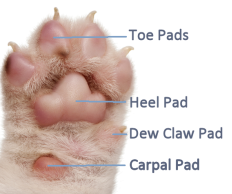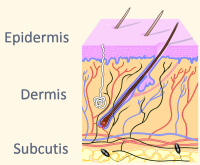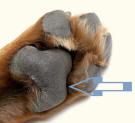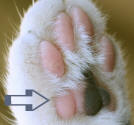Glossary

Foot
The distal part of a limb that bears weight, and facilitates locomotion and manipulation.
Also known as paw (with reference to the feet of dogs and cats).

Also known as paw (with reference to the feet of dogs and cats).

Cutis
Outer layer of skin.
Consists of the epidermis and dermis.

Consists of the epidermis and dermis.

Keratin
A protein that is deposited to form hard, tough and water-resistant epidermal (skin) tissues.
Keratin forms the outer layer of epidermis, hair, nails, claws, hoofs, horns and feathers.

Keratin forms the outer layer of epidermis, hair, nails, claws, hoofs, horns and feathers.

Subcutis
The layer of tissue directly underlying the dermis, but is not considered to constitute the true skin.
It consists primarily of connective (collagenous and elastic) tissue and fatty (adipose) tissue.
It consists primarily of connective (collagenous and elastic) tissue and fatty (adipose) tissue.
Carpal Pad
The limb pad located at the carpus.
Carpal pads of cats and dogs do not usually contact the ground, because they are elevated by the pastern.

Carpal pads of cats and dogs do not usually contact the ground, because they are elevated by the pastern.

Tarsal Pad
The limb pad located at the tarsus.
Tarsal pads of cats and dogs do not usually contact the ground, because they are elevated by the pastern.
Tarsal pads of cats and dogs do not usually contact the ground, because they are elevated by the pastern.
Metacarpal Pad
The limb pad located at the
metacarpophalangeal joint.
This is the largest of the pads on the palmar surface of the forefeet of cats and dogs.

This is the largest of the pads on the palmar surface of the forefeet of cats and dogs.

Metatarsal Pad
Limb pad located at the
metatarsophalangeal joint.
This is the largest of the pads on the plantar surface of the hind feet of dogs and cats.

This is the largest of the pads on the plantar surface of the hind feet of dogs and cats.

Digital Pad
Limb pad located at the level of the distal interphalangeal joint of each digit (toe).
Each toe of a cat or dog, including the dew claw (if present), usually has a corresponding pad.

Each toe of a cat or dog, including the dew claw (if present), usually has a corresponding pad.






